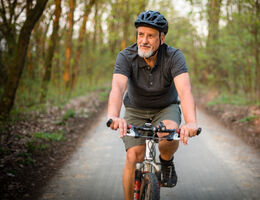
April 5, 2024—If you have back pain or arthritis, cycling—outdoors or on a stationary bike—is a great way to get in some aerobic exercise.
Cycling is a popular, low-impact exercise for a reason. But, just like with any kind of exercise, the wrong equipment or posture can cause discomfort or even lead to overuse injuries. So after you check with your doctor to make sure that bike riding is right for you, set yourself up for a comfortable ride with these tips.
Find the right bike
The Arthritis Foundation recommends test-riding one of these body-friendly bikes:
- Cruisers have higher handlebars and lower seats than road or racing bikes. They're perfect for a comfortable ride on flat, smooth terrain.
- Mountain bikes have a heavy, stable design with built-in suspension that's great for trails or the street.
- Hybrid bikes can help you go the distance. They have larger wheels, narrower tires and lighter frames than a mountain bike.
- Long and low recumbent bikes have a wide, high-backed seat that evenly supports your torso while relieving the strain on your arms, shoulders and back. Some even offer a rechargeable battery for extra pedaling power.
Get the most out of your ride
- Adjust the bike for your body. If you can, get the experts at your local bike shop to help. Raise or lower the seat so your knees are slightly bent when your leg is extended on the down pedal. Change the height and angle of the handlebars to give your arms, neck and back the most comfortable ride too.
- Pace yourself. Gradually increase how long and how fast you ride each time. Cycling more than your body can handle at first can be discouraging and even cause injury.
- Stick with it. Strengthening muscles and improving your endurance takes time. Be patient. Track your riding over time to make it easy to see how you improve.
- Practice good riding posture. Don't round your back. Keep your grip on the handlebars firm but relaxed. Change positions often to keep from getting too stiff.
- Stop and stretch often. Staying in one position for too long can overuse muscles. Do neck stretches and shoulder shrugs. Stretch tight hip, leg and hamstring muscles to prevent hunching, which may cause neck pain. Adjusting your grip can ease muscle strain too.
- Dress for comfort—and safety. Padded bike shorts prevent chafing. Avoid loose clothing that can get caught in gears or the wheels. Stop kneecap pain with shoe inserts, wedges beneath your shoes and properly adjusted cleats. And always wear a helmet.
Gear up for a safe season
Cycling is a great way to get moving. But it has its hazards too. Find out how you can equip yourself for a safer ride.
Sources
- American Academy of Orthopaedic Surgeons. "Bicycle Safety." https://orthoinfo.aaos.org/en/staying-healthy/bicycle-safety.
- American Academy of Orthopaedic Surgeons. "Starting an Exercise Program." https://orthoinfo.aaos.org/en/staying-healthy/starting-an-exercise-program/.
- American Orthopaedic Society for Sports Medicine. "Cycling Injuries." https://ncys.org/wp-content/uploads/2022/02/2022_ST_Cycling-Injuries.pdf accessed via https://www.sportsmed.org/search#q=cycling%20injury&t=All&sort=relevancy.
- Arthritis Foundation. "14 Ways to Work Out With Arthritis." https://www.arthritis.org/health-wellness/healthy-living/physical-activity/other-activities/14-ways-to-work-out-with-arthritis.
- Arthritis Foundation. "Essential Bike Accessories." https://www.arthritis.org/health-wellness/healthy-living/physical-activity/other-activities/essential-bike-accessories.
- Arthritis Foundation. "How to Find the Right Bike." https://www.arthritis.org/health-wellness/healthy-living/physical-activity/other-activities/how-to-find-the-right-bike.
- Arthritis Foundation. "The Benefits of Stationary Biking." https://www.arthritis.org/health-wellness/healthy-living/physical-activity/other-activities/benefits-of-stationary-biking.